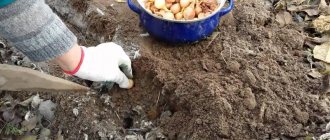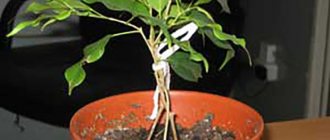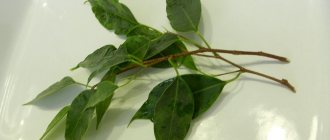Preparing for the ficus propagation process
It is better to prepare a special place where all subsequent actions will be carried out, so as not to carry the plant pot, tools, etc. from place to place during the process. And also to immediately provide the plant with everything it needs. If side shoots are required for propagation, their growth can be influenced in advance. To do this, you need to trim the ficus in a timely manner. The top is usually cut off, after which shoots will begin to appear on the sides of the plant.
Depending on the method, special tools may be needed:
- regular scissors or a knife with sharpened blades, a stationery knife, a blade. A blunt instrument is absolutely not suitable, since it can injure both the plant itself and the future seedling, which will lead to death .
- For propagation, in addition to cutting tools, special mixtures and containers for germination are required
- You need to prepare the necessary soil and drainage.
How to make a house plant beautiful?
If the ficus has grown too much, what should you do? This question often worries novice flower growers. In this case, experts advise pruning the plant. This procedure is best done in spring or summer, when the tree is actively developing. If the crown is formed in the fall during the dormant period, then the shoots will begin to grow only where pruning has been done, and you will not get an even bush. In addition, new branches will use up nutrients from the plant and weaken it during the dormant period.
It is not recommended to form a crown immediately after transplantation, so as not to increase stress. For cutting, use garden shears, pruning shears or a knife. Tools are first disinfected with an alcohol-containing solution, and the cut points are lubricated with garden varnish.
Conditions for reproduction
- the young plant is very sensitive to temperature conditions, so the florist will have to constantly monitor this indicator;
- the correct location of the flowerpot is also of great importance for the development of a young crop at home;
- for several days after propagation, it is necessary to carry out regular watering and monitor the level of moisture in the soil;
- after propagation or transplantation, fertilizing should be carried out no earlier than two weeks after rooting;
- It is necessary to plant propagation material in the ground according to certain rules, which will be described in the following sections.
Ficus benjamina
Transplanting this type of plant is no different from other ficuses. You should always remember: the younger the plant is, the more often it is replanted due to the rapid growth of roots and branches. Young Benjamin varieties up to three years old are planted annually by transferring them into a larger container. After the age of three, this manipulation is carried out once every three years, and sometimes less often. When the plant is more than 12 years old, only the top layer of the substrate is replaced annually. How to plant Ficus Benjamin is described in the article.
It should be remembered that after transplantation the pot is placed in a permanent place; ficuses do not like rearrangements. The flower should be well lit, not exposed to drafts and located away from heating devices. The optimal temperature is 18–22 degrees.
How to propagate ficus from cuttings
Both apical cuttings and pruning the middle of the shoot allow you to take shoots from ficus plants. The upper ones take root faster. Correct cuttings are obtained from a stem with an internode. The optimal length of the shoot depends on the plant variety: for small-leaved crops such as Benjamin, 10 cm is enough (preferably 3-7 leaves), for rubber-bearing and lyre-shaped plants - 15 cm (2-4 leaves).
- For large-leaved lyre-shaped individuals, 2/3 of the leaf is cut off, reducing the level of evaporated moisture.
- For rubber varieties, gardeners roll the leaves into a tube and carefully secure them with an elastic band or rope, retaining moisture in the shoot.
The milk remaining on the shoot prevents the formation of roots. Soaking the lower part of the stem in warm water (2 hours) and then treating the cut with a growth stimulant will help solve the problem. Having charcoal, many housewives will certainly want to disinfect the cut.
How to take a shoot from a ficus
Cuttings of ficus shoots are carried out with a sharp knife or scissors at an angle of 45 degrees, without lifting your hand. Attempts to break off the stem manually may result in unsuccessful or protracted rooting. Cuttings are taken in March or April.
Before winter, the plant has time to take root and grow stronger. Further replanting is carried out once a year; older plants can be left undisturbed for 3-4 years.
First of all, you should prepare the material for planting. To do this, use sharp scissors to cut off a portion from the top of the crown. If you decide to propagate a variety with large leaves, then each cutting should have at least 3-4 leaves, and the most optimal cutting length is 10 centimeters.
For faster rooting, it is recommended to treat the cut with root formation stimulants, and then place the cutting in water for 2-3 weeks. As soon as the root system is well developed, the young plant can be planted in the ground and continue to be cared for as an adult crop.
Ficus propagation by stem cuttings
When propagating ficus using this method, ficus plants with large leaves are mainly propagated. This is a good way to use part of the stem that has either a leaf or several buds that will later become shoots. If you take a large stem, it can be divided into several parts and used for propagation.
This method is good if you decide to trim or rejuvenate your ficus, or if it happens that the shoot is broken. We take the stem we need, which we will propagate. It can be divided into several parts. The length of each should not exceed five centimeters. And on each piece of shoot there should be a dormant bud or leaf.
Ficus varieties
There are many different types of ficus. Let's look at the most popular ones used for indoor landscaping:
- Rubber-bearing plant is one of the most famous and unpretentious; people like to grow it in offices and homes. It has large oval-shaped leaves with a glossy surface, reaching a length of up to 30 cm.
- Benjamina is a strongly branching tree. The small, sharp-tipped leaves have a leathery, green or variegated surface.
- Cherry-shaped - the leaves are elongated, ellipse-shaped, the glossy upper part is dark green, and the lower part is lighter, covered with a small fluff.
- Rust-red - similar to rubber, but has smaller leaves, is characterized by slow growth and is very hardy. In winter it grows well at a temperature of 6–8 degrees.
Propagation using a leaf
Some professional florists prefer to propagate ficus benjamina using leaves. This method differs from the previous one in more careful care of the young plant, however, from one bush you can get a huge amount of planting material.
The method involves growing a crop from a part of a stem with one leaf.
The lower cut is made at an angle directly along the internode. The segment is immersed in the substrate up to the leaf petiole.
The leaf is twisted into a tube by the owner of the flower and secured with an elastic band. Further actions are similar to rooting a tree cutting.
Important! A separate ficus leaf (without a stem) will certainly take root if left in water for a long time, but the leaf will not produce shoots.
Cutting leaves from the top of the plant
As in the previous case, the work should be carried out exclusively with sharp scissors, which are also recommended to be treated in advance in a weak solution of potassium permanganate. The cut must be made in such a way that a small cutting remains on the leaf, from which roots will subsequently form. To speed up the process, it is recommended to use a root formation stimulator.
After preparing the material, the leaves are placed in a shallow container with water at the bottom. As soon as it produces small roots, we transplant it into pre-prepared soil with good consistency (airy, without lumps). After this, the young plant will need frequent, but not too much watering, otherwise excess moisture will lead to the development of a fungal infection.
Cutting leaves from the bottom of the flower
Also, planting material can be prepared from the bottom of the ficus. Such leaves are more developed, so you do not have to use a root formation stimulator and place planting material in water for a long period. You can immediately plant it in the substrate, moistening the soil abundantly.
After about a month, the planting material will take root well, after which it can be transplanted into another container and you can begin to care for it like an adult crop. However, before that, it is strongly recommended to maintain optimal substrate moisture by spraying and monitor the soil temperature.
Methods for rooting a leaf
Rooting of a leaf is carried out using one of the available methods.
In water
2 leaves with a stem fragment are cut from the mother ficus. The bottom leaf is removed. After processing with root, the workpiece is lowered into a dark glass container. In this case, the sheet should not be immersed in liquid. To prevent the development of pathogenic microflora, it is recommended to add crushed activated carbon to the water. As the liquid evaporates, a new portion is added to the container.
It is better to place the container with the leaf in a well-lit place, but without direct sunlight.
In the ground
After a shower, leave the leaf in water for 2 hours. Next, the cut is treated with root. You can dip it in the powder before planting or let it brew for 10 hours in a stimulating solution.
A pot with a diameter of 10-12 cm is filled with substrate. Its composition includes: perlite, sand (the second component can be replaced with peat). After the filler is moistened, a leaf rolled into a tube is immersed in it along with a peg. The planting is placed in a warm room. To create favorable conditions, polyethylene is fixed on top of the container. In this form, the sprout spends 1-1.5 months until the root system is formed. Periodically, the film must be removed to ventilate the plant. Drafts and sudden temperature changes should not be allowed.
Lifehack! Instead of film, you can use a cut plastic bottle as a cover.
Reproduction by layering
Reproduction by layering can be of two types: aerial and horizontal. Each of these species has its own characteristics, but both of them are more suitable for gardeners who already have experience in plant propagation. Reproduction by air layering is suitable even if the ficus stem is too bare. For propagation in this way, it is also better to use adult plants.
To propagate by layering, you must select a shoot at least 50 cm in height. It is necessary to cut the leaf from the trunk at the height at which you want to get the cuttings. This must be done carefully and ensure that the bark is not damaged in the process. A shallow incision is made at the site where the leaves are cut. A utility knife or blade is best suited for this purpose.
Juice will be released from the cut; it must be removed with cotton wool, constantly soaking until the juice flow stops. A match, toothpick or small sliver is placed in the incision, which will provide oxygen access inside the incision.
Air layering
Still haven't decided how to propagate ficus? Then we recommend that you familiarize yourself with another method that will allow you to get a new plant in a fairly quick period. It is best to use this method on adult plants. Also, to successfully carry out the procedure, you will have to familiarize yourself with the theoretical part of how to do it correctly.
So, as in previous cases, first you need to properly prepare the planting material. To do this, you need to select a developed root shoot on the tree, and then completely clear it of foliage. This must be done extremely carefully so as not to damage the peel in the process. After this, a small incision is made on the stem of the indoor flower with a sharp object. Then all that remains is to moisten the cut with water to form roots in it. You can use a match or a toothpick as a spacer.
The first roots on the stem will appear approximately 15-25 days after the above procedure. After this, the shoot is cut off from the mother plant and planted in a separate container with a pre-prepared substrate. Do not forget that ficus trees do not tolerate drought quite well, so the crop will have to be moistened regularly.
Horizontal layering
Reproduction by horizontal layering is carried out with ficuses with climbing stems. In this case, the future shoot is not wrapped in moss. The stem is also cleared of leaves, grooves are made on the cut with a knife, and then fixed in the ground, having previously treated the cuts with a root formation stimulator. When the cuttings take root, they can be separated from the mother plant and replanted independently.
Propagation by seeds
It will not be possible to grow ficus trees from seeds supposedly obtained at home. What some people think are seeds are actually berry inflorescences. Ficus seeds require pollinating insects to produce seeds. If you want to grow ficus from seeds, you need to purchase them in the store. Propagating ficus by seeds is the most difficult of all methods.
- Before sowing seeds, they need to be treated with a substance to get rid of spores and fungi, “Fungicide” and a growth stimulator.
- As a soil for the future ficus, you should choose a mixture of peat moss (sphagnum) and peat. A mixture of two parts of ordinary humus and one part of sand is also suitable.
- Before planting plants, it is better to sterilize the soil with steam.
- A flat container is best suited for planting seeds - it will be convenient to cover it with film and monitor the soil moisture and the behavior of the seeds. It is necessary to have drainage holes to remove excess liquid. The container must be clean and disinfected.
The soil should be poured into a container, lightly crushed and sprayed. You cannot water the soil. Seeds are laid out on moist soil. You should not place them too close to each other so that they do not experience a lack of light.
The temperature during the germination period should not fall below +22–+23 degrees. If the seeds are exposed to direct sunlight, they will die. The film must be periodically opened and closed so that the seeds have access to fresh air. Do not over-moisten the soil. Instead of film, you can use glass, which will be more convenient. When the seeds sprout, they need to be accustomed to a room climate. To do this, it will be convenient to place the glass on supports, ensuring a constant flow of air to the sprouts. Leave it this way for 3-4 days, allowing the sprouts to get used to the new temperature regime.
Rooting seeds can take a long time. In this case, you need to focus not on some time frame, but on appearance. The seed should take root, and the next stage will be the appearance of leaves. The sprouts are ready for transplanting when they have four leaves or more. You can plant them in a common container, but be sure to retreat a distance of about 4–5 cm.
Young ficus sprouts obtained from seeds require frequent replanting. This is done several times in the first eight months of life. This frequency of soil changes has a beneficial effect on the root system, stimulating its development. After these two months, young plants can be planted separately and feeding with fertilizers can begin.
How to plant and root
It is better to plant plants once a year. This is best done in the spring, and the temperature should be from 24 to 27 degrees.
Seedlings do not like direct sunlight , but they will not develop in complete shade either, so you need to make sure that the plant receives enough light.
The soil should always be kept slightly moist; the plant does not like excess water, but it will not develop in dry soil when planted.
When planting, part of the soil must be replaced and a universal fertilizer added to accelerate growth. It is enough to dilute the fertilizer in water when watering.
If you follow all the recommendations outlined, the shoots will develop without problems, and the planting and rooting procedures will not cause difficulties.
Caring for a young sprout - watering, lighting and temperature conditions
Ficus loves good lighting, but not direct rays, but bright diffused light. Therefore, it is more advisable to place it not on the windowsill, but in a dark place. It is also not recommended to go to dark places, as the shoots will begin to branch in one direction, stretch towards the light source, the leaves will sharply decrease in volume, become faded and inconspicuous.
The plant develops well at temperatures from 18 to 26 C. If the temperature begins to rise, the leaves will begin to dry out. To avoid this, it is necessary to spray and wipe the leaves with a damp cloth. If the flower is irrigated with water with the addition of milk, the leaves will be shiny and glossy.
Watering the young sprout should be regular - every 3-4 days. In summer, you should not maintain such an interval, but water as the soil dries out. In winter, watering is reduced to once a week.
It is necessary to feed the flower from March to October, with intensive growth and crown development - 4 times a month. In summer, it is necessary to alternate mineral and organic supplements every 7-10 days. When replanting, you should thoroughly feed the plant.
While watching the video, you will learn about the propagation of ficus leaves.
Thus, propagating ficus is a fascinating activity. Reproduction of stepsons is possible in several ways, but the sprout takes root best when rooted by leaves. It’s so easy to grow and care for – the main thing is desire.
Peculiarities of reproduction depending on the type of flower
The variety of ficus trees can amaze the imagination. But this can also create a number of problems for those who dream of creating their own garden in an apartment or country house. After all, each plant requires an individual approach and has its own characteristics.
Gardeners use many methods to propagate plants. The most popular among them:
- cuttings;
- using air layering;
- leaf rooting.
The method is selected depending on the type and age of the mother tree.
How to plant a broadleaf ficus shoot?
For propagation of broad-leaved ficus species, the best method is cuttings and leaf planting.
But the easiest way is to plant an adult plant when transplanting:
- A day before moving the ficus to a new pot, it must be watered properly.
- Having rolled out the root ball of an adult plant, carefully examine the sprouts that have already taken root.
- Carefully separate them from the main root, trying to damage as little as possible.
- Plant a new plant in a container with nutrient soil prepared for it.
- Water with a solution containing additives that facilitate rooting.
- Cover with a glass jar or polyethylene, creating greenhouse conditions.
- Water daily and ventilate for 30 minutes.
Important! Both the mother plant and the new ficus need special care after transplantation; do not touch a young (up to 3 years old) tree or a weakened plant.
Without replanting, you can get a new flower by rooting cuttings. To do this, pinch off the top of the ficus - a cutting 10 to 15 cm long, preferably already semi-lignified, and treat the cut site with a disinfectant compound. The shoot is placed in a nutrient solution until roots appear, then planted in the ground.
Some gardeners take cuttings from the middle of the trunk, but they must have at least 3 leaves. The cuttings are also kept in a nutrient solution until roots appear or planted immediately in prepared soil, watered abundantly, the leaves are carefully rolled into a tube or cut in half, which helps reduce moisture consumption and increases the chances of the rapid appearance of new roots.
If everything is done correctly, after a month young leaves will appear on the new tree.
How to propagate ficus benjamina?
A beautiful green tree becomes a real decoration of any room; its dark green shiny leaves, even on the coldest day, remind of a hot summer, pleasing the eye. Straight trunk, dense crown, abundance of foliage - and all this with a fairly small amount of care. This is why flower growers love this ficus. Simply knowing how to propagate a plant is enough.
In the spring, Benjamin needs pruning, without which its crown can grow randomly, giving the tree an untidy appearance. The cuttings remaining in abundance after this are used as planting material.
- On a branch at least 10-15 cm long, leave 3-5 top leaves, and carefully cut off the rest.
- The cuttings are placed in Kornevin solution or any other nutrient mixture for accelerated root formation.
- The container with the cuttings is left in a shaded, but not too dark place, with a constant temperature of about 23 degrees.
- After 2-3 weeks, when the cuttings produce the first roots, the plant is placed in specially prepared soil for ficuses and covered with film or a jar.
- Water generously and carefully, not allowing the soil to dry out.
- After another 2-3 weeks, the plant produces new buds, which means it has taken root.
Interesting! Completely shed leaves on a cutting do not mean that it has died. This is how the plant tries to retain the nutrients necessary for root growth. Don't panic or get upset; the roots will appear in a few days.
How to root a ficus tree?
Robusta, Tineke, Belasta and other types of tree-like ficus are rubber trees; in their natural environment in a hot, humid climate they grow to gigantic sizes. In Thailand and India, these ficus trees are considered sacred, helping to maintain peace in the family and removing negative energy.
Transformed by breeders into ornamental plants for landscaping apartments, these beauties still amaze the imagination with their power. Huge leathery dense leaves that seem to be covered with wax, a powerful stem, and air layering help to create chic green compositions from these plants.
For reproduction, as a rule, apical shoots are taken from them.
Attention! Rubber plants can damage the skin of your hands with their juice and cause burns, so you need to wear gloves when handling them.
- The top of an adult plant is cut off at an angle with a sharp tool, leaving up to 5 leaves on the cutting.
- Rinse the cut area with the released juice under the tap.
- Roll or cut the leaf blades in half.
- Place in a nutrient solution poured into an opaque container until roots appear.
- Transplanted into soil for further growth.
Sometimes shoots are germinated in sand, which is constantly moistened, but this takes more time and does not make it possible to notice the appearance of roots.
How to breed the Bengal species?
One of the most interesting species, in nature one tree can seem like an entire forest. And all thanks to aerial roots that appear on long branches, descend to the ground and sprout, turning into strong trunks. Flower growers, taking advantage of this feature, create compositions from aerial roots in the form of openwork patterns, braids, and lattices.
Ficus Bengal can be bred at home, propagating not only with the help of aerial roots sprouted in the soil, but also with cuttings and seeds - after flowering, berry-like fruits appear on it, which birds feed on. Flowering of these ficuses is a frequent occurrence, so getting seeds is quite possible.
- Seeds are sown in light peat soil in small containers with sides about 5 cm in height.
- Sprinkle sand and peat soil on top (layer no more than 1 cm).
- Well moisturizes.
- Cover the container with glass or transparent film.
- Ventilate and water every 3-4 days.
- Seedlings take up to 2 months to germinate.
- The container with the sprouts is placed in a bright, warm place, they wait for the first leaves to appear, and then, 3-4 months after the sprouts appear, they are transplanted into pots.
A labor-intensive process that requires constant attention is fascinating for true connoisseurs who observe the process of tree growth from the first moments of its appearance.
This species is also propagated by cuttings, germinating layering from lignified lateral and apical shoots.
Breeding and planting large-leaved ficus
Among the ficuses there are specimens that are striking in the size of their leaves. Some plates grow up to half a meter in length; lyre-shaped ones surprise with carved edges and veins, the pattern of which makes them look like this musical instrument.
Large-leaved ficus can be propagated by seeds, although this is perhaps the most exotic and difficult method. Most often by layering - cuttings that are germinated and rooted, or by roots on an aerial stem devoid of bark, or planted with leaves.
- A large leaf with a stalk on which there is a bud is cut with a sharp instrument.
- Wash off the juice with warm water.
- Place in a bowl with Kornevin or another nutrient mixture.
- Cover with glass or film, making a “mini-greenhouse”.
- Germinate for a month.
After thin, fragile roots appear, the plant is planted in a small pot filled with drainage and a mixture of peat, sand and a small amount of garden soil. The plant is covered with a glass jar. Moisten the soil, shading and making sure that the temperature is constant and not lower than 23 degrees, wait 3 months. When the ficus begins to grow and the first leaves appear on it, it can be planted in a larger container.
Important! Good saturation of the earth with oxygen is required, so the containers must have holes. Not only at the bottom, but also on the sides.
When planting a leaf with a cutting in the soil, it is not recommended to bury the plant: if the growth point is under a layer of soil, the ficus will die. Neutral light soil, warmth, constant gentle moisture and watering with root growth activators give good results.
Description
Before considering how to propagate ficus, you need to pay attention to the characteristics of this plant. This includes a whole group of plants. They belong to the mulberry family. Plants called ficus can take the form of a tree, vine or shrub. Many of them have aerial roots. That's why they are also called epiphytes.
When the roots reach the ground, they form trunks. In this case, the plant is called ficus banyan. Sometimes aerial roots grow into the bark of another tree. This is a “suffocating” ficus. In the wild, this plant can grow up to 30 m in height. But at home it does not exceed 4 m. However, this is the limit. Usually this is a very small plant.
How to grow ficus at home? This is a fairly simple technique. There are several ways to do this. Depending on the species, the leaves of this flower can be lobed or serrated. They can be arranged alternately or oppositely. Each gardener will be able to choose the best option for himself. The appearance of ficuses is quite varied.
Flowers can have very different shapes. The fruits of this plant are called nuts. They are surrounded by a false fruit with juicy pulp. When damaged, the roots of the flower secrete milky juice. It is poisonous in some plants. This should be taken into account by those property owners who have cats or small children living in their apartment or house.
Ficus trees are native to the tropics. This determines their care needs. Less commonly, such a plant can be found in the subtropics. In warm countries, ficus trees are grown outside. In our country, this is an indoor, heat-loving plant, which is represented by a huge number of species and varieties.










